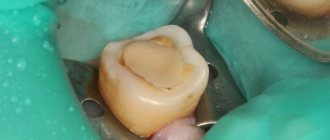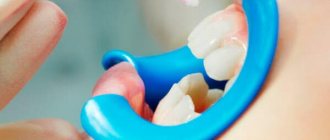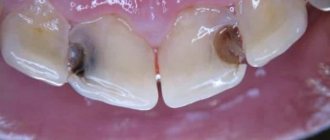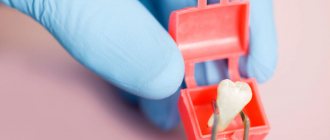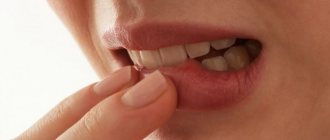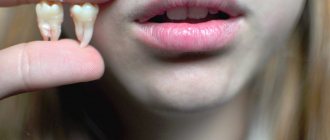Loose teeth are often accompanied by pain and discomfort. This unpleasant phenomenon occurs in people regardless of gender and age, so when unsteadiness appears, appropriate measures must be taken immediately. Most patients immediately go to the doctor when the first symptoms appear, but there are other methods. More details about methods of treating loose teeth at home will be discussed in this article.
Loose teeth - what to do at home
If the tooth is a little loose
If your teeth have just begun to loosen, then you need to urgently take preventive measures. If you don’t know why your teeth have become loose, then it’s better to see a doctor for control.
What to do after being examined by a doctor:
- Brush your teeth and rinse your mouth twice a day.
- Correct the bite if there is deformation.
- Monitor the condition of your gums.
- Eat right, including vegetables, fruits and foods rich in fluoride and calcium in your diet.
These methods will help strengthen your teeth and prevent further loosening.
Diet
It is important to balance your diet.
The problem of row mobility may appear due to improper or irregular nutrition. Review your entire diet carefully. Analyze how rich it is in vitamins and microelements. It is possible that you will need to add some products.
We offer you a list of vitamins and minerals necessary for dental health. In brackets we provide a list of those products in which they are contained in the maximum quantity.
- Vitamin C strengthens mucosal tissue (citrus fruits).
- K – prevents bleeding (dairy products, greens).
- Zinc – prevents inflammation (garlic, onion).
- Phosphorus – fights periodontal disease (seafood).
- Calcium – strengthens enamel (cheese).
- Tannins – relieve inflammation, heal wounds (red wines).
- Ubiquinone – prevents stone formation (nuts).
If you supplement your treatment with proper nutrition, you can not only strengthen your teeth, but also cure common diseases.
Don’t forget, loose teeth are a signal that you are adopting the wrong lifestyle. It cannot be ignored! It may be worth giving up bad habits and establishing proper, nutritious nutrition. Maintain good oral hygiene, visit the dentist regularly, take care of your health, and you will not encounter such a problem.
Part of the molar is movable
Teeth can become loose and fall out in parts. When half a tooth is loose, the dentist takes an x-ray to determine whether the root is affected or only the outer part of the crown is damaged. If the root is not damaged and the base is preserved, then it can be saved. The upper part of the crown is removed and a pin is installed in its place. Then extension is carried out. If the pin cannot be placed, then a polymer filling is placed, and a crown is placed on it. When a tooth becomes very loose and the root is crushed, it is removed and an artificial crown is placed in its place.
How to install a filling
Filling is a rather complicated process, because it is very important to return the tooth to its original appearance and place the filling correctly.
The process is carried out in several stages:
- To begin with, all dark and softened dentin is removed from the carious cavity. It is also necessary to avoid the formation of too thin tooth walls.
- Next, the surface is washed and disinfected with antiseptics.
- The cavity is dried.
- Deep and medium caries require the application of a therapeutic pad with calcium. This helps relieve inflammation and also has a good antimicrobial effect.
- Next, an insulating gasket is applied. This allows you to protect the tooth from the toxic effects of materials.
- Next, the filling itself is placed on the tooth. The method of its installation depends on the type of materials (silicate, composite, antimagnetic filling, etc.).
- At the end, sharpening is performed to get rid of discomfort when closing the jaws. Next, the filling is ground and polished. It is important that it matches the anatomical shape of the tooth (has cusps, grooves).
After all stages are carried out correctly, you can hope to restore the functionality of the tooth and its attractive appearance.
Degrees of mobility
Should the teeth be a little loose? Each element of the dentition has slight mobility, despite the fact that it is invisible. The condition is a natural physiological feature of the elements of the series. Significant swaying of teeth is a pathological phenomenon that indicates problems in the human body.
In total, there are 4 degrees of severity of dental problems:
- 1 – loosening occurs at a distance of more than 1 mm compared to healthy units;
- 2 – not only horizontal, but also vertical instability of the elements is observed;
- 3 – the tooth deviates significantly from its original position in both the vertical and horizontal directions;
- 4 – strong rotation of the element around its axis is noted.
A specialist will be able to determine the degree of progression of the pathology. To do this, he uses special dental tweezers.
Incorrectly processed filling
Almost always, modern treatment at the dentist is carried out under local anesthesia (pain relief). In this state, not only do you not feel pain, but your other sensations may also be dulled. And when the doctor “grinds” an already placed filling to the teeth from the opposite jaw, he may, based on your dull sensations, do this not in full. The filling will come into contact with the teeth of the opposite jaw prematurely, which may cause pain.
What to do after a blow
Dental bruises are closed injuries received after strong mechanical impact. (hitting a hard object). In this case, the teeth remain in place, do not move, but may begin to move. The front ones are especially vulnerable. If your front tooth becomes loose after an impact, you should immediately consult a doctor so that you can save it. X-rays and electroodontodiagnosis are prescribed. The latest diagnostic method makes it possible to see the beginning of the development of tissue necrosis and remove dying particles to prevent inflammation.
As a rule, medications are not used for tooth bruises. Swelling of the gums is relieved with cold compresses, and the patient must be on a liquid diet for some time to keep the molar at maximum rest. Sometimes, dentists practice grinding the cutting edge of the tooth and the cusps of the opposite tooth on the lower jaw, which the patient touches when chewing food.
Causes
The main reason when the filling between the teeth interferes or if the composite material has increased the height of the dental unit is the increased volume of the filling composition used.
This situation is especially typical if therapy was carried out using local anesthetics. In this case, after the treatment, it is difficult to discern how correctly the jaw row closes. And the person, upon arriving home, begins to experience a feeling of discomfort.
Another cause may be periodontitis. In this case, the damaged crown does not cause tooth mobility. But after restoring its integrity, the disease manifests itself with the appearance of a symptom of the inability to close the jaw tightly.
In addition, there are cases when a filling on a front tooth interferes. This occurs when a composite material is placed between the incisors. Since they are in close contact with each other, they can move.
An excessively thin wall between the pulp chamber and the installed filling, when chewing, can create increased pressure on the dental nerve. The patient perceives such sensations as a defect in the installed filling material.
A complaint from a patient when a temporary filling interferes can occur both due to excessive application of liquid elastic paste, and when medicine is placed in the tooth cavity.
You can get a quality consultation on wisdom teeth in your city
Now regarding orthodontic treatment and wisdom teeth. Believe me, it is very unpleasant for us doctors, as well as for patients, to make radical decisions. But there are good reasons! These are your own stories.
All the beauty of straight teeth, especially the lower incisors (you just started to enjoy a beautiful smile) - it disappears at 20 and beyond. It is when most of us fully develop these “eights”.
Two, three and even four years of therapeutic “torment” to correct crooked teeth, transform them into a beautiful/sweet/courageous smile, as they say, down the drain... Yes, yes - the only option to become the owner of beautiful teeth again is repeated orthodontic treatment.
Our body is beautiful and magical in that it almost always adapts and compensates for almost any pathology. Therefore, the “eights” erupt with difficulty, and subsequently deform the very important teeth in front!
If the root one is unsteady
Often a healthy tooth begins to hurt sharply and become loose. Permanent teeth can also become loose, even if they are molars. You don’t need to endure it, but go to the dentist. The doctor prescribes disinfectants: rinsing with chlorhexidine and furatsilin solution, gel applications.
If the gums are inflamed, then anti-inflammatory and regenerating drugs are prescribed. (“Trental”, “Olazol”, etc.). Physiotherapy also helps stop the process. For example, vacuum massage, darsonval, ultrasound procedures.
After stopping the inflammatory processes in the oral cavity, the dentist strengthens the teeth in the correct position and applies a temporary splint. If a wisdom tooth is loose and hurts, it is most often removed since it does not play a special role in the chewing process.
Chronic apical periodontitis in the acute stage
It sounds scary...and in reality it is no less terrible. The mechanism of pain in this case is quite simple. Around the apex of the root, surrounded by a dense bone plate, the inflammatory process is activated. Inflammation in all parts of our body proceeds along approximately the same path and is characterized by an increase in the volume of inflamed tissue (due to blood flow to the affected area).
And if this happens, for example, when a hand is bruised, then we will see swelling, that is, an increase in volume. Now let’s imagine the formation of a “swelling” in the area of the root apex surrounded by a dense bone plate... there is no room for the incoming fluid, the nerve endings are compressed, and here you are also trying to chew a delicious steak!
Front
The upper front teeth are very mobile, so they often begin to wobble. To find out the reason for this, a comprehensive examination is carried out, including a panoramic photograph of the oral cavity. What to do if your front molar is loose?
After determining the causes, a complete sanitation of the oral cavity is required to destroy infectious pathogens. If periodontal disease is detected, the specialist performs a special massage on the gums, darsonval procedures. If signs of periodontitis are detected, then be sure to remove stones and plaque, and polish the teeth with an ultrasonic beam. The entire surface of the tooth, including the neck, is polished with a brush using medical varnish containing fluoride.
Difficult deposits are removed with curettes, which pass under the gums, pulling out deposits. Open curettage is also performed, where the gum is cut and then stitched back together. Additionally, medications are prescribed that relieve inflammation with an antiseptic effect.
If the upper front teeth of an adult are seriously damaged or separated, a splint is placed on the upper jaw. A small hole is drilled in the molar into which fiberglass is placed. After which everything is covered with any composite substance that reflects light rays. Thus, during the movement of the front jaw, the molars do not move apart.
Pain after depulpation
If caries is not treated, chronic pulpitis may occur, requiring pulp removal. In such cases, the doctor removes the pulp, which is inflamed, cleans the canals and closes them using filling agents. This treatment guarantees the elimination of the problem; a slight pain syndrome may bother the patient for some time, but this will pass in two weeks.
We suggest you read: Jaw hurts when chewing and radiates into ear
If, after treatment of a tooth, the tooth hurts severely when pressed even after two weeks, then the reasons for this are the following:
- A foreign object got into the canal that the dentist was treating. This sometimes happens when particles of a medical instrument enter the affected area during treatment, this leads to pain when pressing and chewing.
- During treatment, the walls of the tooth root were affected, this is called perforation. In order to clarify, it is necessary to remove the tooth with an x-ray.
- Filling material has not been placed on the entire surface of the canal.
- carious lesions were not completely removed, so the filled tooth hurts with slight pressure.
All of the above are dental errors that require a visit to the doctor to eliminate these causes.
Professional dental treatment
Only a dentist can effectively strengthen loose teeth. As soon as you notice that your teeth have begun to loosen, you need to go to the doctor. He will conduct a professional diagnosis and determine the causes of this pathology. Based on them, he will prescribe subsequent treatment. He can also carry out:
- removal of plaque and stone;
- strengthening physiotherapy;
- injections of special medications (if indicated).
Strengthening teeth is a complex process. With a competent approach to treatment, you can cope with even the advanced stage of this pathology. The following medications are often prescribed to treat loose teeth:
- Retucan (antiseptic);
- Ascorutin (strengthening drug for blood vessels);
- medicinal pastes (Parodontol, Parodontax, etc.);
- rinsing solutions.
In combination with other products, you can use special toothpastes.
Curettage of the gum pockets is often also performed. This procedure involves the doctor using special instruments to clean the gum pockets from accumulations of food and stone.
In what cases are fillings installed?
Filling material is used for:
- Treatment of pulpitis and periodontitis.
The pulpitis therapy procedure is carried out in several sessions. It involves removing nerve endings from the root canals and replacing them with a special filling material. During the first procedure, arsenic paste is first applied to the chewing three and four root teeth.
After thoroughly cleaning the canals, they are filled with a special filling material and sealed with gutta-percha pins. To assess the control of the work done, the dentist sends the patient for a repeat x-ray.
Treatment of periodontitis in most cases is long-term. Root canals are not filled as long as there is an inflammatory process in them. The tooth cavity is constantly open. The patient performs antiseptic rinses at home.
- Treatment of caries. The procedure is carried out during one session. It consists of removing pathological tissues, carrying out antiseptic treatment, and forming new tooth tissues using filling materials;
- Carrying out restoration work aimed at improving aesthetic and practical qualities. Composites are installed for: pathological tissue abrasion, tooth chipping after injury, wedge-shaped defects, fluorosis.
We invite you to read: Treatment of cervical caries. Causes and symptoms
If necessary, during therapy, the dentist uses local anesthesia. Modern anesthetics have good analgesic properties and have a small number of contraindications and side effects.
After the injection, part of the patient’s jaw becomes completely numb and pain is not felt. After installing the filling, the doctor checks how well it matches the bite. This can be checked using a special carbon copy.
The specialist places a copy sheet in the oral cavity at the place where the filling material is installed and asks you to bite it and move it slightly with your jaws from side to side. After the carbon paper is removed, places on the filling that need to be sanded are visible.
It often happens that after installing a permanent composite, a person cannot adequately judge his occlusal comfort due to the effect of anesthesia. After it ends, the patient begins to feel discomfort.
We invite you to familiarize yourself with: Mask for correcting bite
In this case, you should not wait for a long time for the material to shrink or wear off. There is no need to try to get used to the inconvenience. Just go to an appointment with the dentist who performed the treatment.
You should not ask the dentist to “cut down” the filling too much in advance to avoid possible overestimation. The upper and lower teeth must be in contact with each other to ensure proper chewing of food. In addition, the removal of teeth from the bite (a special reduction in their height) can lead to a decrease in the distance between the upper and lower jaws.
https://www.youtube.com/watch?v=ytpressru
Remember!
If after installing the filling (coming home, the next day or some time later) you notice that the filling is bothering you and you feel uncomfortable closing your mouth, then if possible, contact your dentist. He will once again check the contact points of the teeth using a carbon copy, find out your subjective sensations (where, in your opinion, it is interfering) and adjust the filling. It will take literally 5-10 minutes and will save you from further problems.
In addition, if you feel that the edge of the filling is sharp and injures the surrounding tissues (tongue, cheek, gum), that the filling is not polished enough, that there is a gap, gap, step, etc. between the filling and the tooth. – also consult a doctor for correction. If there are undercuts, gaps and roughness, there is a risk that plaque and microbes will accumulate under the filling or on it, and a relapse of caries may develop in this place over time. The dentist will quickly and painlessly polish the problem area and thereby prevent possible consequences.
Often, patients, after coming from the dentist, note that the filling prevents the teeth from closing and moving the jaw; it is very difficult to close the mouth. Therefore, it is important to figure out what to do in this situation.
First of all, it is worth noting that this situation occurs quite often. After the doctor has filled the tooth, he lets the person bite on the carbon paper to see if the filling is bothering him. If yes, he corrects and polishes it. But it often happens that after dental treatment a patient feels a millimeter of extra filling, invisible to the doctor.
Many people think that the situation will improve in a few days and the jaw will get used to it. This is a big misconception, since current filling materials are very strong and resistant, so it takes years, not days, to wear off. It is important to remember that if it is difficult to move your jaws with your teeth closed and you constantly feel discomfort, you should not tolerate it under any circumstances.
— If a tooth gets in the way, additional stress is placed on it, leading to injury. If you don’t consult a specialist, you can get pulpitis or periodontitis; as a result of these pathologies, the tooth will have to be depulped, and this is not a pleasant procedure.
— The load to which the filling is subjected will soon lead to its chipping or spalling of the tooth walls.
— When a misalignment of the jaw occurs, the body gradually gets used to it, but the problem does not go away, and after a while the temporomandibular joints will begin to hurt. Symptoms of this pathology are pain in the joints and their crunching.
It is important to pay attention to the following points:
- There is no need to ask the doctor to “file down” the filling more than necessary, for fear of overestimation, since the upper and lower jaws should be in contact with each other while chewing food. The height of the filling should not interfere with the bite and cause inconvenience to the patient.
- If, after coming home, the discomfort after the filling does not go away, you need to visit a doctor the next day so that he can relieve you of this problem in a matter of minutes.
- When the edge of the filling is very sharp and causes injury to the cheek, gum or tongue, you should immediately go to the doctor to polish it.
- Often, a person may see a small gap at first glance between the filling and the tooth. But in fact, bacteria and microbes can multiply in it, leading to caries. Therefore, a trip to the doctor in this case is also inevitable.
We suggest you read: How can you rinse your mouth when you have gum disease?
What to do if, after visiting the dentist, you find that your teeth cannot fully close together, the filling is very bothersome to you. A person's first thoughts may be:
- It's okay, time will pass and I'll get used to it;
- I'll wait a couple of months, the material will settle a little or wear off;
- As much as I don’t want to visit the dentist again, shouldn’t I use a nail file to correct the situation?
Despite the initial flow of thoughts, it is necessary to approach the situation sensibly, be prudent and take care of your precious health. Remember! Modern filling materials are very strong. They wear out and shrink, but this takes a very long time. As a result, while a person endures inconvenience, he is likely to develop complications.
What to do if your teeth are loose and your gums hurt
When gums bleed and become inflamed, teeth can also become loose and even fall out. One of the factors that provokes this condition is acute or chronic gingivitis. The inflammatory process provokes a light plaque on the teeth consisting of microbial pathogens or the formation of tartar on the teeth if you do not take good care of the oral cavity. If gingivitis is not treated, the germs travel deeper into the tissue. Periodontitis develops when pus forms on the gums, the necks of the teeth are exposed, and constant pain appears.
With periodontitis, the inflammatory process occurs in the tissues, from the base of the tooth root. At the same time, gumboil appears and the gums become very swollen and painful. Sometimes, due to chronic infection, cysts form on the gums; they do not appear immediately. In severe cases, a granuloma forms on the gums, in which bacteria attack the gums and roots of the teeth. In this case, the person experiences severe itching and high fever.
Also, gums can hurt after tooth extraction, installation of implants, braces, appliances, or improper dental treatment.
If your teeth are loose in your gums, you should not:
- Press your finger on the gum
- Heat with compresses, sand, warm rinses
- Open an abscess at home
- Taking too many painkillers
First of all, you need to relieve pain with pills or injections. But under no circumstances should you exceed the dosage. Paracetamol, analgin, ketanol and other similar products are suitable. You can also use gels with an analgesic and cooling effect.
You can rinse your mouth with Chlorhexidine and Miramistin. This needs to be done in the morning at lunch and in the evening to get results.
Poorly restored contact point
A contact point is a point or area through which adjacent teeth contact each other and through which chewing pressure is distributed. If the carious cavity was located on the side surface of the tooth and after filling it, the contact point was not properly restored, then food will get clogged between the teeth when chewing, injuring the gingival papilla. Hence the pain. This reason relates more to the second group, so let’s move on to it.
We suggest you familiarize yourself with Plaque on teeth - what to do and how to remove: removal at home and at the dentist
Why is this happening?
As already mentioned, there are quite a few reasons for this problem. They can be divided into four main groups.
Gum diseases
This is one of the main reasons. All inflammatory periodontal diseases (periodontal disease, gingivitis, periodontitis) weaken the attachment of roots to the gum tissue. This is why mobility and obvious swaying begin.
In addition, there are also cysts and granulomas that affect the root and lead to the same result.
There are quite a large number of diseases, one of the manifestations of which can be called loose teeth. Here is a short list of them.
- arthritis (joint disease);
- diseases of the heart and cardiovascular system;
- psoriasis is a chronic dermatosis affecting the skin;
- problems with the thyroid gland;
- diabetes;
- tumor neoplasms;
- osteoporosis.
We suggest you read: What to do if the crown falls off a tooth or falls out along with the pin - solution to the problem
Injuries
With strong impacts or other similar impacts, the tooth can also become loose. Most likely, this impact led to a fracture in the root area, so it can no longer properly hold the crown. It is also possible that inflammation forms at the site of the impact, then this could also be the cause.
Injuries can also include bruxism - grinding due to uncontrolled clenching of teeth.
Pregnancy period
At this time, the woman’s body undergoes strong changes. In particular, metabolic processes associated with the absorption of calcium are disrupted, which may also be the cause of this problem.
Many people, after reading reviews from patients, decide for themselves that removing eights is a very dangerous and painful matter. In fact, everything is somewhat different. Firstly, removing a wisdom tooth does not hurt, because the doctor always gives pain-relieving injections in such a quantity as to completely turn off the sensitivity in this area.
The dentist is not an inquisitor, and he also does not like to see the patient suffer. Secondly, not all eights have crooked roots, which, as is known, makes them difficult to remove. Wisdom teeth are famous for their bizarre shapes, that's a fact.
But it is also a fact that many eights have only one root, or three, but straight ones. Therefore, the removal of the eighth tooth should be regarded as a normal extraction, and not as an exceptional case.
As for impacted and incompletely erupted teeth, then, indeed, the qualifications and experience of a doctor are necessary. Such teeth are somewhat more difficult to remove and the healing period takes a little longer.
How to relieve severe pain at home?
If the doctor warned you after filling about the possibility of toothache and gave the necessary advice, then with this symptom you need to strictly follow the specialist’s recommendations.
When the pain takes you by surprise, the first thing you need to do is clean the tooth from any leftover food and rinse your mouth thoroughly with warm, but not hot, water. The next step is to take one tablet of pain medication.
Drugs and their contraindications
There are many medications that temporarily relieve pain: nimesil, nise, ibuprofen, nurofen, analgin, baralgin, ketorolac, ketarol, nimulid, coffedon, ketonal, actasulide and their analogues. Taking aspirin orally will also help for a short time, and paracetamol for severe pain.
Painkillers are not a treatment for toothache; in addition, they have contraindications against the background of stomach and duodenal ulcers, kidney and liver diseases, hypertension, heart disease, pregnancy and breastfeeding.
Household products
- The most popular and effective method is rinsing with soda and salt. To prepare it, you need to add a teaspoon of baking soda and salt, preferably sea salt, to a glass of warm boiled water. Rinsing with a solution of furatsilin or hydrogen peroxide will help relieve pain.
- A cotton pad moistened with valocordin or tincture of valerian is used as an applicator on a sore tooth. For this purpose, use a paste of salt, garlic and onion in equal proportions and cover with a cotton or gauze swab.
- For 5-10 minutes, apply a piece of ice wrapped in one layer of sterile gauze or bandage to the painful area.
- After half an hour, the pain will gradually subside if you place a piece of unsalted lard on the cheek of the sore tooth.
- You can hold a small amount of strong alcoholic drink behind your cheek. This remedy is suitable only for adults who have no contraindications.
